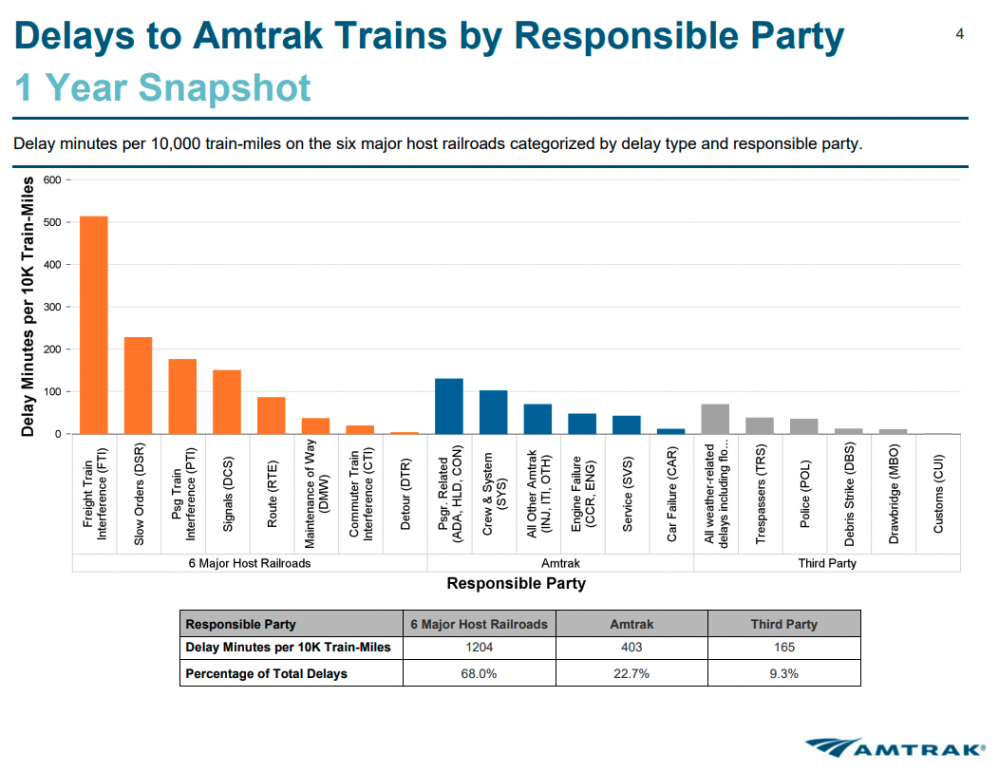Happening Now
March Saw Little Improvement for Late Trains
April 14, 2023
by Jim Mathews / President & CEO
Customer on-time performance (OTP) data are out for March today from Amtrak's Host Railroad Group and it ain’t pretty: once again, not one single Amtrak long-distance service met the new regulatory standard for Customer OTP. State-supported routes, as a group, came closer to meeting the standard but slipped in March compared with the 12-month average. The Northeast Corridor – which Amtrak fully controls – did better in March than the 12-month average, and easily met the new regulatory standard.
Customer OTP measures the percentage of all customers on an intercity passenger train who arrive at their destination no more than 15 minutes after the Amtrak-published arrival time. Delay Minutes measures the average number of minutes of delay on a particular route.
Freight Train Interference continues to be the biggest single driver of late trains, although many other causes also play a role.
 Unsurprisingly, the largely Union Pacific-hosted Sunset Limited was once again the worst performer, running late 78 percent of the time as it has for the past 12 months. The average delay minutes per rider in March on that train was ever-so-slightly better than the 12-month average – the typical late Sunset rider was one hour and 51 minutes late in March, compared with the 12-month average of two hours and 32 minutes late.
Unsurprisingly, the largely Union Pacific-hosted Sunset Limited was once again the worst performer, running late 78 percent of the time as it has for the past 12 months. The average delay minutes per rider in March on that train was ever-so-slightly better than the 12-month average – the typical late Sunset rider was one hour and 51 minutes late in March, compared with the 12-month average of two hours and 32 minutes late.
The Lake Shore Limited came closest to meeting the new OTP standard, coming within three percentage points of making the grade. It’s also 11 percentage points better in March than the route’s 12-month average of 66.5 percent. However, when a Lake Shore passenger was late they were later than they had been during the previous 12 months: 78 delay minutes per passenger compared with a 67-minute 12-month average on that route.
Overall, the long-distance trains as a group were marginally better than the 12-month average in March, operating at just under 50 percent Customer OTP.
Even though the State-Supported corridors, as a group, failed to meet the Customer OTP standard many individual routes easily made the grade in March. The Cascades, the Downeaster, the Adirondack on the Empire service, the Ethan Allen Express, the Maple Leaf, the run between New York and Albany, the Pere Marquette, and the Hiawatha were solidly in the high 80s – the Adirondack and Hiawatha topped 90 percent on-time.
But the worst-performing state-supported routes looked as bad, or even worse than, what we’ve become used to seeing on the long-distance side of the ledger.
The Heartland Flyer posted a dismal 11.1 percent Customer OTP score in March, some 40 percentage points from its 12-month average. In other words, Heartland Flyer passengers were late 88.9 percent of the time, and the typical Flyer rider was 53 minutes late in March.
Northeast Corridor trains in March ran 86.3 percent on time by the Customer OTP standard, five percentage points better than the NEC’s 12-month average. And the Acela ran on time 88.7 percent of the time in March. You might be surprised to learn which train was Amtrak’s on-time champ in March, however: the Keystone service ran 94.7 percent on time in March, just a skosh under its 12-month average of 95 percent and the clear winner in Amtrak’s system for the past 12 months.
"Thank you to Jim Mathews and the Rail Passengers Association for presenting me with this prestigious award. I am always looking at ways to work with the railroads and rail advocates to improve the passenger experience."
Congressman Dan Lipinski (IL-3)
February 14, 2020, on receiving the Association's Golden Spike Award
Comments